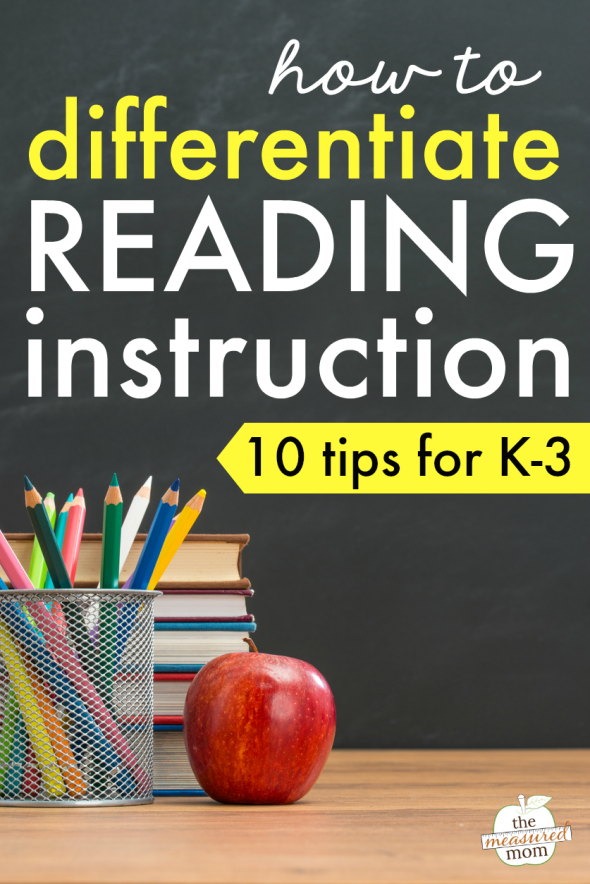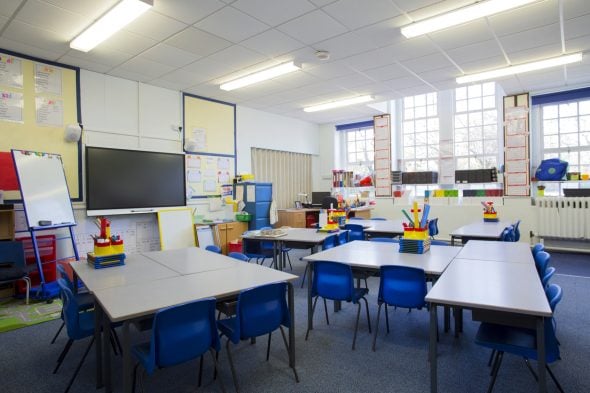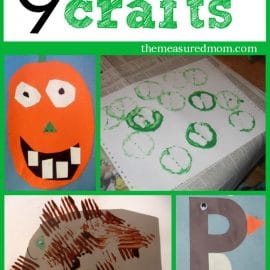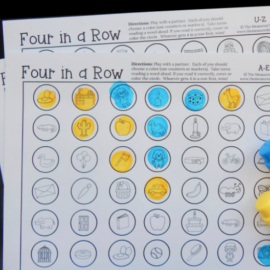Looking for tips to achieve differentiated reading instruction in K-3? You’re in the right place!

(This post contains affiliate links.)
Differentiation.
It’s the big buzz word these days, isn’t it?
But what does it really mean?
Simply put, differentiation is tailoring your instruction to meet the needs of individual learners.
According to Carol Ann Tomlinson, “Differentiating instruction means ‘shaking up’ what goes on in the classroom so that students have multiple options for taking in information, making sense of ideas, and expressing what they learn.”
Differentiation is not …
- giving the same instruction and assignments to the entire class, day after day.
- giving busy work or extra problems to early finishers.
- doing something different for every student in your classroom. (Whew!)
Differentiation is …
- a flexible approach to instruction.
- adjusting how we teach based on students’ readiness levels, interests, and learning styles.
- changing the way we teach so that everyone – the advanced, struggling, and on-level readers, LEARN.
Here’s the thing.
Differentiation isn’t easy.
But here’s the good news!
By following a few key tips, you can learn to meet the needs of all your readers.
And you can do it with the time you have – without burning yourself out.
Let’s take a look at ten tips for differentiating reading instruction in K-3.
10 tips for differentiating reading K-3
1. Take the time to teach structure and routines.
Boring, right? I mean, why spend a couple of weeks practicing routines when learning to read is so much more fun?
If you’ve taught for more than a week, you know the answer.
If we skip over the routines, it’s only a matter of time before our classrooms become a hot mess. Every time we try to sit down with a small group, we’ll be interrupted. There will be commotion and quarreling at center time. Before long we’ll want to grab a stack of identical worksheets and throw our differentiation dreams out the window.

We all know that it’s important to teach structure and routines. But how do we begin?
The trick is to think about all the moving parts that will make your reading block run smoothly. Then model what you want to see. And practice, practice, practice.
Consider:
- How will students assemble for read aloud time?
- How will they move through learning centers?
- How will students choose their own books?
- How will they “help themselves” when you are busy with a small group?
- What will they do when they finish their work?
- How will you minimize noise?
- How will students work productively in small groups?
2. Organize your classroom library.
I used to recommend leveling much of the classroom library using Fountas & Pinnell’s guided reading leveling system.
I no longer recommend this, because after studying the science of reading I no longer support using the early predictable books with beginning readers.
Instead, I recommend building up your collection of quality decodable books and giving them their own bins.
I also recommend sorting books by series and topic.
3. Assess regularly, and plan how you’ll use the results.
When you think of assessment, what comes to mind? For many of us, assessment is that thing we do at the end of the unit to see if our students “got it.” But that’s just one way to assess – and considering it’s after the teaching has concluded, it’s not even the most effective!
Consider all the ways to gather information about your learners!
- conversations with students
- classroom discussions
- student work
- observation
- formal assessments
Whether you’re referring to the results of formal instruction such as Acadience Reading (my favorite!) or informal notes that you jot down during small groups – you’ve got to decide what to do with the information.
I suggest recording the data on a spreadsheet. Use the chart to group students with similar needs. Then make plans for how to address their needs in small groups or in individual reading conferences.
4. Structure your reading block for differentiation.
If your reading instruction is typically a block of whole class instruction, it’s hard to differentiate.
I recommend starting the reading block with differentiated instruction in phonemic awareness and phonics, using small groups. If possible, involve other teachers at your school so that each of you teach just two total groups; that way, everyone can receive this instruction every day.
Then do whole class lessons in comprehension, vocabulary, and fluency.

A smart way to conclude your reading time is with an interactive read-aloud.
5. Rethink independent reading time.
Back when I was a student (ahem) years ago, silent reading time was about promoting the enjoyment of reading. In hopes of achieving that, teachers made sure that every child was occupied with a book. It could be ANY book, as long as it was made of paper and had words in it. The teacher read at the same time (or graded papers).

Times have changed. While we certainly want our students to learn to enjoy reading, our goals for independent reading time are bigger than that. It’s a teaching time.
I recommend giving each child a bag of books with books s/he is responsible for reading. For most early readers, these should be decodable books that feature phonics patterns you’ve already taught.
You might also include small versions of text you’ve read together during shared reading.
Finally, consider allowing kids to have “dessert books” that they enjoy looking at but cannot read yet. (Insist, however, that they practice their decodable books first.)
A final tip: Beginning readers should spend most of the reading block getting explicit instruction and reviewing previously learned skills, not spending 30-40 minutes doing “independent reading.” Increase the independent reading time when they are ready.
6. Don’t be afraid of explicit instruction.
For years I’ve been a balanced literacy advocate, but as I learn more about the science of reading I’ve experienced a shift in my thinking.
I used to be afraid of explicit instruction … to me it could only mean boring-snoring drill and kill.
But when you have a strong reading curriculum with hands-on materials, explicit instruction can be pleasant and – yes- even fun.
7. Use flexible grouping.
The reality is that you probably have your low, medium, and high readers. And there will be many times that it will make sense to group them accordingly. But not always.
Whatever you do, don’t create labeled, permanent groups that never change.
8. Give kids meaningful work, not busy work.
Your explicit, whole class lessons are important. Your explicit, small group instruction is important.
But your centers are important, too.
It’s tempting to create cute center activities without stopping to consider our goals and objectives. We might want to keep the kids busy so we can focus on the “important” learning in our small groups.
Rather than make the learning centers cute, isolated activities, use them as an extension of whole and small group instruction. Make sure the activities feature skills students have mastered; they can use the center to practice the skills to automaticity.
For quality centers, check out these!
9. Make the work for all learners equally appealing.
Don’t give your low learners worksheets while the advanced learners get to play a game.
10. Take it slow, and be easy on yourself.
During my first years of teaching I took one subject to improve on each year. I spent all summer reading, studying, and planning for how I was going to take my teaching to the next level.
You can have the same approach to differentiation.
Add new strategies to your toolbox each year.





Wanda
Hi Anna,
Thank you for the information. How exactly do you use Book Wizard. Sorry, my keyboard’s question mark isn’t working. Anyway, I clicked on the link you gave but was a a quandary as to how exactly I wanted to level my books. I teach K and have a ton of books but was wondering if there was a way I could enter the titles and the system would tell me.
Wanda
I’m sorry. I went back and didn’t see the search bar. I got it now.
Anna G
Great! 🙂
Cindy
Thank you for this information. I teach Adult Education at a non-profit Mental Health Facility. Some of our members are age 50+ and were “passed though” the public school system without them ever acquiring the most basic reading skills. I’m trying to assess their levels without any formal testing materials, then differentiating their materials to their abilities. For an adult, it can be difficult to find interesting materials at a 1-4 grade level. There is one man, with whom I’ve been working with for over a year, that just doesn’t get it still. It is difficult when I only work with him for 30 minutes to an hour a week…
Anna Geiger
I can only imagine how challenging that would be, Cindy! Thank you so much for your dedication!
Lisa Dorsett
This is excellent information and very informative. Thank you for sharing! ?
Anna Geiger
Thanks for reading, Lisa!
Marya Fonsh-Mielinski
Hi! I love all the freebies I can get now that I “belong” to your site and I loved the tips on this post. The drag is that I cannot figure out how to access the printable for differentiation tips! 😉
Am I just missing it somewhere on the freebies page? I don’t think that it was ‘sent’ directly to my inbox in the welcome email…sometimes my email at school is weird, and sometimes (she admits) I am not so good at technology 🙂
Thanks!
Anna Geiger
Hi Marya! Feel free to send me an email, and we can figure it out: anna(at)themeasuredmom(dot)com.
Mahesh Kumar
Hi Anna, These are really some wonderful things you have mentioned here. My kid has just started in play school. I should keep these things in my mind, it’ll help me search a better school for my kid. Thanks a lot for sharing.
Anna Geiger
You’re very welcome, Mahesh!
Jimmie Brown
Excellent information, thank you
Anna Geiger
You’re welcome, Jimmie!
Robyn
Great article, as always! Thank you for sharing from your treasury of knowledge.
Anna Geiger
Thank you, Robyn!
Jacqui Jacobs
THANK YOU for sharing! Awesome ideas. So grateful.
Anna Geiger
You’re very welcome, Jacqui! 🙂
Parul
Very exciting to work like this.
Elaine
Thank you for sharing
Anna Geiger
You’re welcome, Elaine!
tessy
Thank you so much.
Anna Geiger
You’re welcome, Tessy!